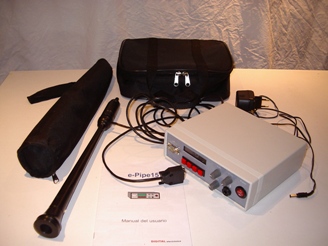
FolkWorld Issue 39 07/2009; Article by Pio Fernández
Made in Portugal
More Electronic Bagpipes
Practicing at home with a musical instrument can create problems, mostly for the people around you. When we talk about a woodwind instrument such as bagpipes, the situation is even worse, since many of these loud and high pitch instruments were conceived for outdoor playing (even on battlefields!). Using an electronic version with earphones is an excellent option to practice day or night in your living room, and without irritating family, pets, neighbours, …
|
The (Galician) gaita or gaita de foles is a traditional bagpipe used in Galicia, and Portugal. The name gaita is used in Galician, Spanish, Leonese and Portuguese as a generic term for "bagpipe".Just like "Northumbrian smallpipe"' or "Great Highland Bagpipe", each country and region attributes its toponym to the respective gaita name: gaita galega (Galicia), gaita transmontana (Trás-os-Montes), gaita asturiana (Asturias), gaita sanabresa (Sanabria), sac de gemecs (Catalonia), gaita de boto or gaita aragonesa (Aragón), etc. Most of them have a conical chanter with a partial second octave, obtained by overblowing, in the same way as e.g. the Eastern European gaida. Folk groups playing these instruments have become popular in recent years, and pipe bands for some models.In Bulgarian the same instrument is called GAIDA. Maybe the Wisigeths are the link between both sides! It is possible that the name originates with the ghaita (also spelled rhaita in Morocco and algaita in Niger) a North African oboe similar to the zurna whose name derives from an Arabic word meaning "farm,", and/or the Eastern European bagpipes bearing similar names, such as gaida, gajda, and gajdy, but the linguistic relationship, if any, between these instruments is still unclear. The word gaita might also be derived, according to Joan Corominas, from a Gothic root meaning goat (gait or gata), as the bag is a whole, case-skinned goat hide; Gothic was spoken in Spain as late as the eighth century due to Visigothic invasions. The InstrumentThe Galician gaita has a conical chanter and a bass drone (ronco) with a second octave. It may have one or two additional drones playing the tonic and dominant notes. Three keys are traditional: D (gaita grileira, lit. "cricket bagpipe"), C, and Bb. Galician pipe bands playing these instruments have become popular in recent years. The playing of close harmony (thirds and sixths) with two gaitas of the same key is a typical Galician gaita style. Though bagpipes are associated to the traditions of Scotland, they are actually found throughout Europe, North Africa, the Middle East and India, including Aragon, Catalonia, León, Majorca, Zamora and Portuguese Minho, Trás-os-Montes and Extremadura. The term gaita may refer to a variety of different pipes, shawms, recorders, flutes and clarinets in different areas of Spain and Portugal. The instrument was common and popular by the 15th century, followed by a decline until the 19th century renaissance of the instrument. The early 20th century saw another decline. Then, beginning in about the 1970s, a roots revival heralded another rebirth. The folk revival may have peaked in the late 1990s, with the release of acclaimed albums by Galician Carlos Núñez (A Irmandade Das Estrelas). Traditional use include both solo performances or with a snare-drum known as tamboril (a wooden natural-skinned drum with gut snares), and the bombo, a bass drum. Galician bagpipes come in three main varieties, though there are exceptions and unique instruments. These include the tumbal (B-flat), grileira (D) and redonda (C). DescriptionThe player inflates the bag using his mouth through a tube fitted with a non-return valve. Air is driven into the chanter (Galician: punteiro) with the left arm controlling the pressure inside the bag. The chanter has a double reed similar to a shawm or oboe, and a conical bore with seven finger-holes on the front. The bass drone (ronco or roncón) is situated on the player's left shoulder and is pitched two octaves below the key note of the chanter; it has a single reed. Some bagpipes have up to two more drones, including the ronquillo or ronquilla, which sticks out from the bag and plays an octave above the ronco, or the smaller chillón. These two extra drones are located next to the right arm of the player. The finger-holes include three for the left hand and four for the right, as well as one at the back for the left thumb. The chanter's tonic is played with the top six holes and the thumb hole covered by fingers. Starting at the bottom and (in the Galician fingering pattern) progressively opening holes creates the diatonic scale. Using techniques like cross-fingering and half-holding, the chromatic scale can be created. With extra pressure on the bag, the reed can be played in a second octave, thus giving range of an octave and a half from tonic to top note. It is also possible to close the tone hole with the little finger of the right hand, thus creating a semitone below the tonic. SongsTunes using the gaita are usually songs, with the voice either accompanying the instrumentation or taking turns with it. The most common type is the muiñeira, a sprightly 6/8 rhythm. Other 6/8 Galician tunes use different steps; they include the carballesa, ribeirana, redonda, chouteira and contrapaso. Alborada, usually-instrumental tune, most often in 2/4, though sometimes 3/4, and is characterized by a series of descending turning phrases. It is used to begin a day's celebrations, and is played at sunrise. The foliada is a joyful 3/4 jota-type song, often played at romarías (community gatherings at a local shrine). Famous Gaita PlayersGalicia: Avelino Cachafeiro, Perfecto Feijoo, Os Campaneiros, Moxenas, Xuán Vázqüez, Os Rosales, Carlos Núñez, Anxo Lorenzo, Xosé Manuel Budiño, Cristina Pato, Susana Seivane. Asturias: José Ángel Hevia |
A less acoustically impacting alternative to the real pipes set is to use a traditional practice chanter, or some kind of whistle or flute. But such kind of instruments do not get close to the real feeling and effort of: blowing air in real pipes while controlling the bag pressure with the arm, and doing the fingering on the chanter. And the buzzing or whistle sound can still drive mad your wife and kids after a long practice session.
 |
The kind of electronic bagpipe system described in this article is named e-Pipe, and it is made in Portugal by the firm DIGITAL Electronica. Its current version was developed to resemble the chanter and drone sound of the traditional Galician or Asturian gaita bagpipes, the main ones played in Northern Spain and Portugal. I cannot say if there are equivalent products in the market with better or worse characteristics. But compared to what I have tried and seen so far, I believe that this e-Pipe provides the closest solution to the traditional wood pipes with natural reeds & bag made from little goat skin (actually Goretex bags are becoming more and more popular).
The inventor of the e-Pipe is the Portuguese electronics technician Rui Manuel DE OLIVEIRA. As an amateur gaiteiro, three years ago he initiated the project to develop an electronic chanter capable to exactly reproduce the behaviour of the real instrument. For that, he had the support of the Galician Fernando FORNEIRO-ARCE, who is a maker for wooden gaitas as well as many kinds of traditional Galician percussion instruments. After initial prototypes and tests performed by professional and amateur gaiteiros, Rui Manuel has patented the design of the electronics of the e-Pipe, and is the manufacturer for that complete system, while Fernando is the maker for the chanter in plastic material. Rui and Fernando have already sold over one hundred of e-Pipes, mainly in Spain.
It was the maker of my traditional Galician pipes, the late José Luis TEIXEIRO, who showed me for the first time the e-Pipe system. What I found really good is that he could actually plug the electronic chanter to his normal pipes set, and the synthesized sound would not start until the bag was filled with air, and pressure was put by the arm. Just like the real thing. I was not too impressed by the kind of synthesized sound, but the invention obviously presented a lot of advantages, as you can recognize along the following description.
The e-Pipe is based on two parts : the Chanter and the Electronic Box.
The e-Pipe model 15 comes with each part and accessories inside a soft nylon fabric case.
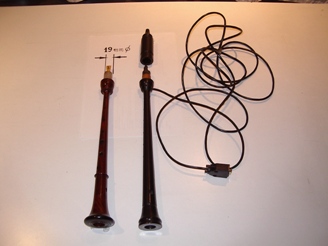 The Chanter is a Polypenco plastic conical piece, with the length, diameters, holes size & arrangement (7 holes on the front, 1 on the rear), almost identical to those in a traditional Bb (Si_bemol) bagpipe, like the Galician ‘Tumbal’ type, or the Scottish GHB (Great Highland Bagpipe). The chanter keeps inside all the electronic sensing elements, capable to detect : the position and quick movements of the fingers on the holes, as well as the pressure of the air which is being supplied. This pressure level signal is used to trigger the start of the synthesized sounds for both the chanter (‘puntero’ in Spanish) and the bass drone (‘roncón’). The drone sound is only the bass one, as in the Gaitas or the GHB : two octaves lower than the chanter base note. A potential improvement for this system would be to incorporate tenor drones sound (one octave lower than the chanter base note).
The Chanter is a Polypenco plastic conical piece, with the length, diameters, holes size & arrangement (7 holes on the front, 1 on the rear), almost identical to those in a traditional Bb (Si_bemol) bagpipe, like the Galician ‘Tumbal’ type, or the Scottish GHB (Great Highland Bagpipe). The chanter keeps inside all the electronic sensing elements, capable to detect : the position and quick movements of the fingers on the holes, as well as the pressure of the air which is being supplied. This pressure level signal is used to trigger the start of the synthesized sounds for both the chanter (‘puntero’ in Spanish) and the bass drone (‘roncón’). The drone sound is only the bass one, as in the Gaitas or the GHB : two octaves lower than the chanter base note. A potential improvement for this system would be to incorporate tenor drones sound (one octave lower than the chanter base note).
The chanter comes with a plastic mouthpiece that can be removed, if you want to plug this part in a standard bagpipe set. What you have to do in this case is to put some conical stoppers (rubber, wood) in the exit holes of the bagpipe drones, if you want to avoid their natural sound.
The chanter is connected to the electronic box by a 3 meter long cable. This is something that, as said by the manufacturers, is going to be improved soon replacing it by a wireless system.
The Electronic Box has two panels : front and rear.
The front panel has a connector for the chanter cable, and a female jack connector to plug in a set of earphones or loudspeakers. The panel also includes an illuminated ‘liquid crystal’ display, 4 buttons to select different functions and modes, and three rotating knobs to adjust the sound volumes : chanter, drone and global. The functions allow features such as :
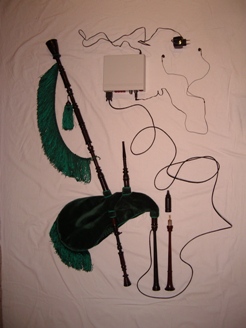
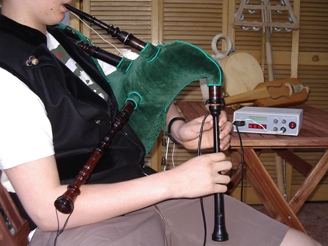
The feature that this system does not incorporate is an air flow adjustment. There is some fixed small air leak through the electronic chanter, but may not be sufficient to simulate the kind of airflow that your traditional pipes take in their natural operation. There is a very simple fix that you can do by putting wood stoppers on the drone’s outlet holes. Then you can make some fine grooves along the side of the stoppers until you get a similar kind of [pressure/airflow] ratio as the one in your traditional pipes.
The rear panel has three female connectors for : MIDI, jack ‘Insert’, jack ‘lineout’, plus the one for the power source (12Vac/400mA). The e-Pipe can be connected to a PC and the sound signals processed by standard commercial music programs.
Except for the cable that connects the chanter to the electronic box, playing the e-Pipe chanter plugged in your traditional bagpipes, makes it almost the same as the real ones. I have even seen it already used on stage by professional musicians such as the Galician singer Mercedes Peón, in a concert where she combined traditional and modern folk tunes, with other electrical instruments. Obviously, this electronic chanter provides her a guaranteed perfect tunning, independent of ambient temperature and humidity. For traditional instrument musicians coming down from the north of Spain to play in the country’s central and southen regions, these kind of climatic variations can really be a nightmare, mostly in the summer.
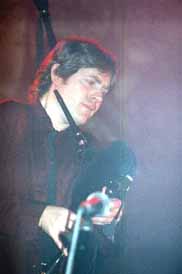


 |
Photo Credits:
(1)-(4) e-Pipe
(by Pio Fernández);
(5) Xosé Manuel Budiño,
(6) Carlos Núñez,
(7) Susana Seivane,
(8) José Ángel Hevia (by The Mollis).
|
To the German FolkWorld |
© The Mollis - Editors of FolkWorld; Published 07/2009
All material published in FolkWorld is © The Author via FolkWorld. Storage for private use is allowed and welcome. Reviews and extracts of up to 200 words may be freely quoted and reproduced, if source and author are acknowledged. For any other reproduction please ask the Editors for permission. Although any external links from FolkWorld are chosen with greatest care, FolkWorld and its editors do not take any responsibility for the content of the linked external websites.
